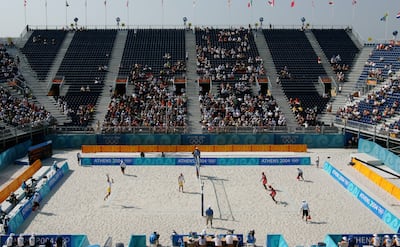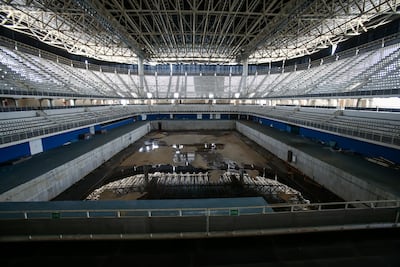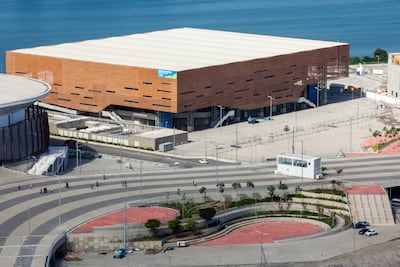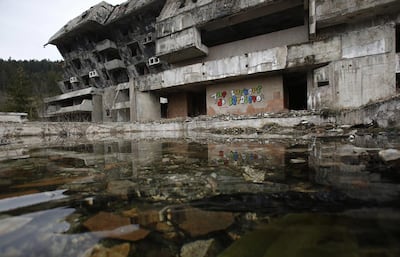Paris implemented a unique and thoughtful plan for hosting the Olympic Games, which will surely set the benchmark for how future cities will accommodate the landmark event.
Instead of building new venues, organisers opted to adapt existing structures in the French capital. The idea was to highlight the city’s storied history. However, the fear of spending billions on new spaces only to watch them fall into white elephants or states of disrepair – as many previous host cities have done – is undoubtedly another factor behind the decision.
Here, The National looks at venues that never found a second life after the Games – and a couple that did.
Abandoned: Faliro Olympic Beach Volleyball Centre, Athens

The Faliro Olympic Beach Volleyball Centre looms in Athens as a downtrodden white elephant – a potent symbol of a financial disaster that hamstrung the Greek economy for two decades. The centre was boisterous during the 2004 Olympics, accommodating almost 10,000 spectators. With its amphitheatre-like design and steel fixture curving overhead, it was once a site to behold.
Little of that glory remains today. The centre’s floor is strewn with rubble and garbage. The bleachers are caked with dust. The walls are haphazardly decked with graffiti. There is broken office furniture in the halls and discoloured leaflets of the bygone Games caught in the overgrown weeds.
And it isn’t the only Olympic venue in Athens to succumb to this fate. The Greek capital had carried out an ambitious €9 billion development project to prepare, building several sites specifically for the landmark event.
After all, Greece was where the ancient Games began and Athens was where the modern iteration relaunched in 1896. It was a matter of national pride to host the Olympics with due glory and pomp. As such, no expense was spared.
But for the two decades since, many of the venues – including for taekwondo, rowing and hockey – have been left abandoned, finding little to no purpose after the Games. It was only in the last few years that an urban redevelopment project began, aiming to dismantle the abandoned structures to make room for a smart city along the coastline.
Partly abandoned: Olympic Aquatics Stadium, Rio de Janeiro

Conceived as a temporary structure, the Olympic Aquatics Stadium in the Barra Olympic Park remained standing well past the conclusion of Rio 2016.
The stadium cost $38 million. Its architecture was restrained in its rectangular design but featured whirlpool artworks on its facade that were created by Brazilian artist Adriana Varejao.
After the conclusion of the Olympics and Paralympics, its future was contested. There were plans for its parts to be refashioned as community facilities in Madureira Park and the Campo Grande neighbourhood, however, these never materialised.
The centre was disassembled at a languid pace and bit by bit. In 2017, the Brazilian Army took apart the pools, some of which have since found a second life in community centres across Brazil. According to the Rio government, one of its pools will become part of a public park in the city’s West zone.
Partly abandoned: Arena of the Future, Rio de Janeiro

Another Olympic structure that lay abandoned for years before being repurposed is the Future Arena. Like the aquatics stadium, the centre was built with a nomadic principle, with its parts intended to build four schools to accommodate 2,000 pupils.
However, two of these schools were only unveiled in February – eight years after the conclusion of the Olympics. The schools were built in low social development areas in the West zone, where the other two schools will also be opening next year.
Abandoned: Olympic Bobsleigh and Luge Track, Sarajevo

The Olympic Bobsleigh and Luge Track was built for the 1984 Winter Olympics on the Trebevic mountain above Sarajevo.
Tens of thousands of people gathered at the venue during the Games and, for a while, it seemed like the track would remain active after the Olympics. World Cup competitions in bobsleigh and luge were hosted at the site until the Yugoslav Wars broke out in 1991.
The track was used as an artillery position and was significantly damaged during the Siege of Sarajevo between 1992 and 1996. After the war, it became a popular cycling track and a place for graffiti artists to practise.
Renovations began in 2014 but have been gradual and measured due to funding. While it may still be some time before the area can host official championships again, the track has become a fairly popular tourist destination, for both its scenic views as well as graffiti art.
Repurposed: National Stadium, Beijing

Beijing’s National Stadium is a 20-hectare site built specifically for the 2008 Games. The structure is also known as Bird’s Nest and looking at its architecture, it is easy to see why. The structure’s design was a joint effort by the Swiss firm Herzog & de Meuron and the China Architecture Design and Research Group, with celebrated Chinese artist Ai Weiwei serving as an artistic consultant. However, Weiwei distanced himself from the project before it was finalised, boycotting the Olympics as a whole, and calling the project a "pretend smile", according to reports.
Architects studied Chinese ceramics before settling on the nest theme. The site features several unique components, including a rainwater collector that purifies water and dispenses it throughout the stadium. The playing area is also fitted with special pipes underneath that capture heat in the winter and dispel it in warmer months. The National Stadium was the landmark of the 2008 Games, hosting its opening and closing ceremonies as well as track and field competitions.
The site continues to host sporting and cultural events including football, a Formula E championship and the League of Legends World Championship in 2017. The venue has also hosted performances by Jackie Chan, Chinese pop star Wang Leehom and South Korean acts including Kangta, BoA and Tasty.
Repurposed: Queen Elizabeth Olympic Park, London

Queen Elizabeth Olympic Park was specifically built for London 2012. The site stretches across four East London boroughs and features a stadium, swimming pool, the Olympic Village that housed the athletes and several other venues.
During the Games, the site was simply referred to as the Olympic Park but was renamed in honour of Queen Elizabeth II’s diamond jubilee.
After they concluded, the eight permanent venues were developed over 18 months to accommodate communities as well as athletes. Structural components conceived for the Olympics were removed, such as the seating wings of the aquatic centre. New bike tracks were laid, playgrounds and cafes opened and the landscape was reimagined to become a tourist attraction in its own right. The stadium was renamed and became West Ham United's home ground, an English Premier League team.
According to the park’s website, more than 16 million visited the site since 2012 and development projects are continuing so that the park will continue to contribute to London’s economy, providing 40,000 jobs by next year.

